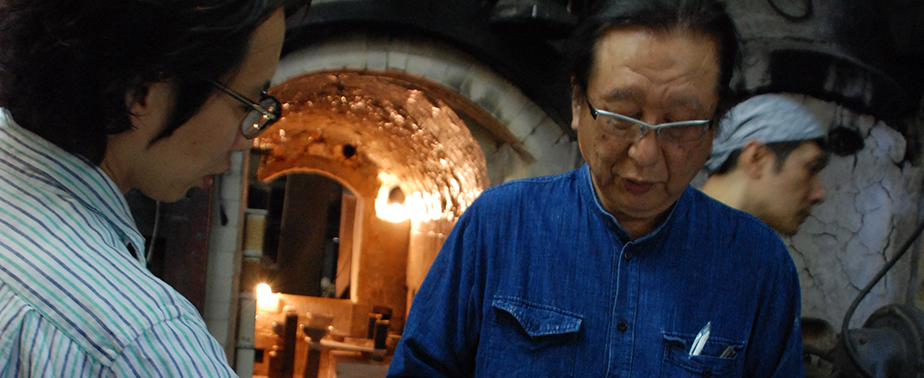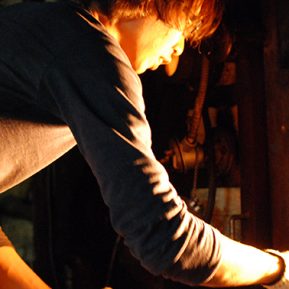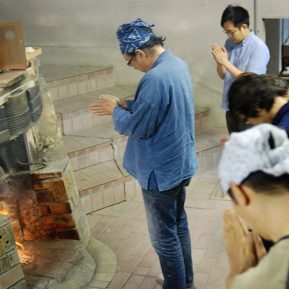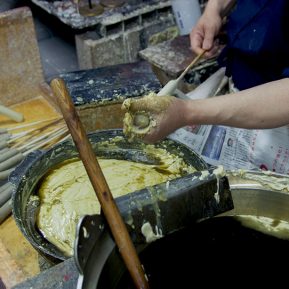
Chawan Benikase Toujinbue by Hosai (15th generation) (Photo courtesy of Asahi Workshop)
Farewell to my father
Later, Yusuke spoke to me about his feelings during the funeral. “My head was full of thoughts on what had happened up until then and how things would go in the future. After that firing, my father went to the kiln one more time a month before he passed. He said every time, ‘This is my last firing,’ but I was sure he had plenty of firings left in him. In the end, [that firing] went as my father said, but I wasn’t prepared mentally at all.“ The death of Hosai, 15th generation of the 400-year old Asahiyaki tradition, attracted a great deal of attention from the world, as did Yusuke, who is likely to succeed him in the near future. However, before they were master and apprentice, they were father and son. But as this is a family who passes pottery down generation after generation, nothing particular happens with the passing of a generation. There is only the sorrow of the family who lost one its own, just as every family experiences.

“This is the story of families everywhere. In the face of a death of a family member, one thinks about it, then has to return to daily life to work hard and continue on with one’s life. I will of course inherit and continue the pottery my father fostered and his spirit concerning it. But, to be honest, I don’t know yet whether that is what you would call ‘succession.’ Cherishing the thoughts of the deceased is natural for every family.”
A new Hosai
June 11, 2016. Six months later. Yusuke’s 16th generation name-taking ceremony was held at Byodoin Jodoin. Here, where his father’s funeral was held, Yusuke inherited the name “Hosai,” the same as his father and his grandfather. Having inherited the name, busy days follow, with production for exhibitions and formal greetings with various people and so on. With no time for grief, the daily work of the Asahi Workshop began. In October 2016, Yusuke held his first kiln firing since succeeding his father as the 16th generation. Soon after the firing was over, Yusuke fell ill because of the sense of relief following the heavy sense of responsibility. “That firing was one of checking new problems one by one. Thankfully the firing ended without problems. But to start with, the work up until the kiln packing was challenging. I thought about how to express ‘myself’ in contrast to my father’s work. But I decided that being caught up in that worry itself was not like Asahiyaki. In the end, I was able to challenge myself to do my best at this point in time.”
This firing was also the first step in how the “new Hosai” would be seen. “I came to call myself Hosai and decided I needed to show my shedding of my “Yusuke” skin. I also know that it’s not easy. There is also a style that I had avoided unconsciously while my father was still alive, so these challenges will continue in the future. I believe my father was a heavyweight of Asahiyaki pottery.” His predecessors protected the traditional style of pottery, allowing Yusuke up until now to go in a different direction, challenging the medium. In the future, he will carry the responsibility of both on his shoulders.

Chawan Geppakuyu Nagashi by Yusuke (Photo courtesy of Asahi Workshop)
“I’m finally used to my father not being at his potters wheel. I feel sad, or lonely. It’s strange for something that was always at my side to be suddenly gone. But, my father not being here will no doubt become normal.”
Good like nothing
“You have to make pieces that are good like nothing.” Yusuke remembers his father often used those words. The definition of “good” is vague, even more so if it concerns a tea bowl, a component of tea ceremonies. A piece that blends well with the tearoom, fits the hand, and has presence without being flashy. It is easy to put into words, but what kind of pottery exactly is that? “For me, I think the ‘Asahiyaki-likeness’ is an indicator of correctness. My father’s work, his father’s work, and the work of previous generations are all different and all have their own characteristics. But, when lined up together, they all share qualities that can be described as ‘Asahiyaki-likeness.’ To borrow my father’s words, I understand it as ‘common yet not mediocre.’ But nothing is more difficult. Thinking now and looking back at the work of my father and my grandfather, they must have thought the same thing.”
That is to succeed
Three months prior to his father Hosai passing away, Yusuke and his wife had their eldest son. For Hosai, it was his first grandchild. During my interview, too, when the conversation turned to this topic, with a smile Hosai said, “He’s fun.” “I am glad I was able to have him see his grandchild. It’s selfish of me, but I wanted to have my son have memories of his grandfather. But time wasn’t on our side. I don’t know if this child will succeed me in Asahiyaki. My father never asked me to follow him. Despite being parent and child, I don’t think this is work to start after being told by someone.” (Yusuke)
The family motto of the Asahi Workshop (Matsubayashi family) is as follows. “Traditions are not to be protected but rather pushed.” Four hundred years have passed since the Asahi kiln was opened in Uji. Looking over that history, difficult times exceed those of stability. It is a family motto that encouraged walking without fear of change that allowed them to maintain a house of tea bowls and continue to fire satisfying pieces. “Never was there more a time to think about succession than the past year. There was just so much to think about—the last firing with my father, my father’s death, the birth of my son. What does it mean to succeed? I don’t have an answer, no matter how much I think about it. But, I’m not worried. I think it is something that I will find along the way before I pass Asahiyaki on to the next generation. I’m sure my father thought the same thing.”

At the Asahi Workshop, clay is mined in Uji and allowed to rest for about 10 years before it is used. Over the years, exposure to rain and wind ages the clay, and the components contained in it change as if the clay were alive. This combined with the flames of the kiln produces the resulting kiln-change colors and patterns known as youhen. Some pottery clay has been stored for 50 and 100 years. Sometimes they are mixed in and used to create new work. Various aged clays are the only material for unglazed Asahiyaki. It is a wealth that cannot be substituted. “Asahi Workshop has always used Uji clay exclusively. There is significant meaning in continuing to create pottery on the same earth. For generations, I used the clay gathered by my father and grandfather, and gathered the clay for my children and grandchildren. We have continued this tradition for 400 years. There may be various styles, but they are all Asahiyaki because of this.” I remember these words spoken by Hosai prior to his passing. For some time, Yusuku will no doubt use the clay prepared by previous generations. And he will continue to gather clay in the same way as his predecessors for the next generation. The obvious is conducted quietly every day. The accumulation of the same everyday activities of previous generations creates a shapeless tradition. Maybe that is the “succession” of Asahiyaki.
Asahi Workshop
11 Uji-Yamada Uji-Shi Kyoto 611-0021, Japan
http://www.asahiyaki.com/
SPECIAL
TEXT BY YUJI YONEHARA
PHOTOGRAPHS BY YUJI YONEHARA
17.01.07 SAT 23:34




